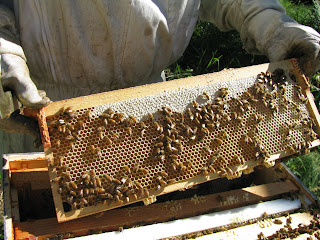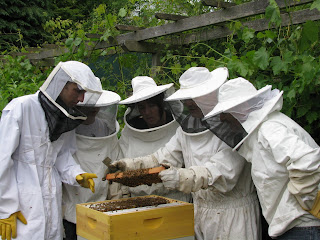
Honey bee working a leek that has gone to flower

A full frame of honey that is almost ready. Note the whiter area along the top of the frame. That honey has a thin wax cap across the top indicating that the bees have decided that it has been sufficiently dehydrated. We take frames of honey from the bees when they are at least 80% capped. Go bees go!

A family, visiting from California, is watching my husband work a hive in our back yard. We love to educate people about bees when we get a chance.

I got stung on the leg two days ago. My body over-reacts to bee venom. So far treatment has consisted of ice, Benadryl, hydro-cortisone cream, and ibuprofen. I looked up some folk remedies and tried a few but I think I was too late for them to have any effect. Ice seems to give the most relief.
This has been a most frustrating summer for beekeepers and presumably for the bees. We have had cool overcast day after cool overcast day. I look at the weather across the nation and see the temperatures in many parts of the country hovering around a humid 95 to 100 degrees and am thankful I don't have to brave that but on the other hand, it does make beekeeping difficult when the bees can't get out to the flowers that I know are blooming. Our bees are finally able to bring in nectar in excess of their needs. We are seeing a lot of uncapped honey that we hope will be ready sometime this week of next week. The bees put a thin coat of wax over the cells of honey when they are dehydrated enough so the honey doesn't ferment.
We hope to be at the Phinney Farmers' Market on the first Friday in August.

